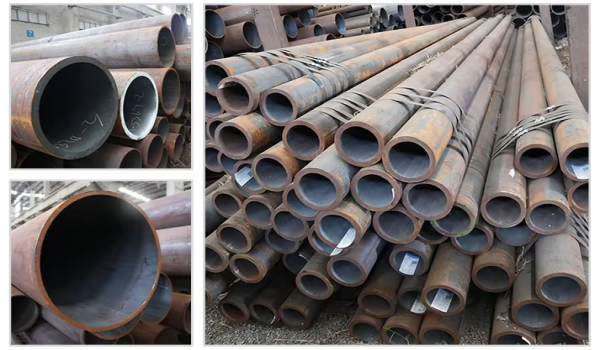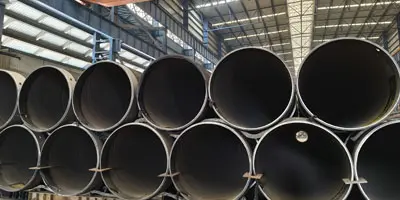What is Carbon Steel Pipe?
Carbon steel pipe is a type of steel pipe made of an alloy of carbon and iron. It is mainly composed of carbon and iron, and also contains trace amounts of other elements such as manganese, silicon, sulfur and phosphorus. The carbon content in carbon steel pipe ranges from 0.04% to 2.1% by weight. Seamless carbon steel pipe is a pipe made of ingot or solid round steel, perforated into rough pipe, and then hot rolled, cold rolled or cold drawn. Carbon steel pipe occupies an important position in the steel pipe industry. Carbon steel pipe is divided into two categories: hot rolled and cold rolled (drawn) steel pipe. Hot rolled carbon steel pipe is further divided into general steel pipe, medium and low pressure boiler steel pipe, high pressure boiler steel pipe, alloy steel pipe, stainless steel pipe, petroleum cracking pipe, geological steel pipe and other steel pipes. Carbon steel pipe also has a variety of manufacturing types, which will be introduced in detail below.
Carbon Steel Pipe Specifications
Carbon steel pipes are available in a variety of specifications to suit different uses. They are available in a variety of sizes, from 1/2” NB to 36” NB. These pipes are manufactured according to different standards, including:
ASTM A/ASME SA 106 Grade A, B, C
ASTM A/ASME SA 53 Grade A, Grade B
API 5L – PSL Grade 1 A, B, X42, X46, X52, X56, X60, X65, X70
ASTM A/ASME SA 333 Grade 1, Grade 6
What are the different types of Carbon Steel Pipes?
Carbon Steel Pipes are manufactured in various types, as listed below:
Carbon Steel Seamless Pipe – It contains more carbon and iron in its composition. Depending on the grade, it is allowed to contain trace amounts of silicon, manganese, and copper in varying amounts. Therefore, the carbon steel seamless pipe material is stronger and extremely stress-resistant. In heavy-duty facilities, these properties make the pipes suitable.
Carbon Steel ASTM A335 Pipe – ASTM A335 P11 seamless pipes are made of carbon steel with a minimum tensile strength of 415MPa and a minimum yield strength of 205MPa. The material has high durability and high wear resistance. They are composed of carbon, manganese, phosphorus, sulfur, silicon, chromium, and molybdenum. The composition of ASME SA335 grade chromium pipes gives them properties such as strength, strength, stiffness, wear resistance, hardness, hot hardness, and corrosion resistance.
Carbon Steel Pipes – have high durability, corrosion resistance, and tensile strength. Carbon steel pipes are used in various industries such as oil and gas industry, chemical industry, metallurgical industry, energy industry, shipbuilding industry, desalination industry, food industry, and pulp and paper industry.
Carbon Steel Welded Pipes – are used for high pressure conditions. Carbon steel pipes are widely used in a range of industries such as water and waste transportation, oil and gas industry, high pressure applications, and chemical manufacturing.
Carbon Steel ERW Pipes – have various features such as light weight, corrosion resistance, reasonable structure, sophisticated design, intricate details, economical, etc. These ERW pipes are used in shipbuilding, automobiles, boilers and pressure vessels, railways, petroleum and petrochemical, coal and mining, transmission towers, and general and heavy engineering.
Carbon Steel LSAW Pipes – have some excellent properties like easy installation, seamless surface, rust resistance etc. Since these LSAW pipes are expensive, they are not widely used in low value non-energy applications like water pipes.
ASTM A106 Pipe: ASTM A106 pipe refers to carbon steel pipes made by hot rolled or cold drawn seamless method. This standard covers seamless pipes designed for high temperature service, making it suitable for conveying fluids like water, oil, gas and slurry. ASTM A106 pipes are essential in the mining industry given their heat resistant properties.
ASTM A53 Pipe: ASTM A53 pipes include welded and seamless steel pipes, usually in carbon black material and sometimes in hot dip galvanized (galvanized). It is a basic pipe material with similar performance and price to ASTM A106B or API 5L B pipes. Sometimes, pipes marked with all three standards are called “triple standard steel pipes”. A53 pipes are widely used in mining and slurry services due to its versatility and reliability.

Carbon Steel Pipe Standards and Grades (Seamless and Welded)
ASTM A106 Gr. B in Seamless (Differences between ASTM A106 and A53 pipe)
ASTM A53 Gr. A, B in Seamless, Welded ERW, and Zinc coated, hot-dipped galvanized steel pipe
ASTM A179 Gr. C in Seamless (For seamless cold drawn low carbon steel heat-exchanger and condenser tubes)
ASTM A192 (For seamless carbon steel boiler tubes for high-pressure service)
ASTM A252 (For welded and seamless steel pipe piles)
ASTM A333 GR. 1, 2, 3, 4, 5, 6 (For seamless and welded steel pipe for low-temperature service and other applications with required notch toughness)
ASTM A134 and ASTM A135 (For electric resistance welded ERW steel pipes)
API 5L Pipe, ISO 3183 / API 5L Gr. A, B, X42, X46, X52, X56, X60, X65, X70, X80 in seamless and welded (LSAW, SSAW, ERW) steel pipe, for petroleum and natural gas industries, steel pipe for pipeline transportation systems.
DIN 2440 seamless and welded steel pipes applies to medium-weight tubes suitable for screwing. (DIN2444 Zinc coated steel tubes, for hot galvanizing)
CSZ Z245 Seamless and ERW welded pipe (low-frequency electric welded pipe excluded), SAW steel pipe that intended for oil and gas pipeline systems.
NBR 8261 Cold-Drawn, Cold-form, welded steel pipe, in circular cross-section, square or rectangular, applied to structural purposes.
AWWA C-200 for steel water pipe
More standards material available in case special requirement
So that’s the types and specifications of carbon steel pipes. We hope to help you better understand both aspects of CS tubes.






 English
English Español
Español بالعربية
بالعربية











 Phone :
Phone :  Whatsapp :
Whatsapp :  Email :
Email : 


